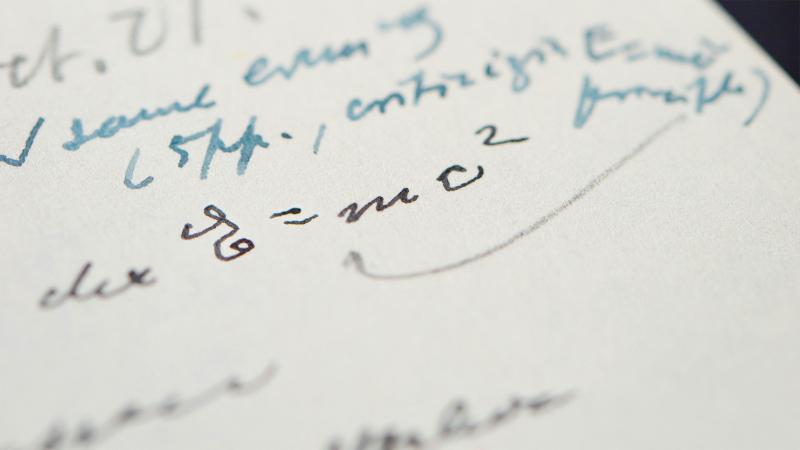A crucial series of Albert Einstein’s calculations, scrawled down as the physicist struggled to account for an anomaly in the orbit of Mercury while developing his theory of general relativity, is set to be auctioned for an eye-watering estimate of up to €3 million (US$3.5 million).
Christie’s France and auction house Aguttes, who will auction the manuscript in Paris on Nov. 23 for an estimate of €2m-€3m, said it documents a crucial stage in the development of the theory of general relativity, and is “without doubt the most valuable Einstein manuscript ever offered at auction.”
Written between June 1913 and early 1914 by Einstein and his friend and collaborator Michele Besso, the Swiss engineer, the manuscript runs to 54 pages, 26 pages in Einstein’s hand and 25 in Besso’s, with three pages written on by both. Covered in equations and calculations, with extensive corrections and crossings-out, it sees the pair tackling the anomaly in the orbit of the planet Mercury, a problem that had bedeviled the scientific community for decades, using the early version of the field equations of Einstein’s general theory of relativity.

Photo: AFP
The point in Mercury’s orbit in which the planet is closest to the sun, its perihelion, shifts slowly over time because of the effect of other bodies in the solar system. If Einstein and Besso’s equations had given the result of the observed shift, the theory would be proved. But the manuscript contained calculation errors — Einstein made a mistake in the value of the mass of the sun on page 28. He set this approach to general relativity aside later in 1913, concerned about its theoretical consistency.
Besso took the manuscript with him when he left Zurich.
“It is thanks to him that the manuscript has, almost miraculously, come down to us: Einstein would probably not have bothered to keep what he saw as a working document,” said Christie’s.

Photo: AP
The manuscript is one of only two surviving works documenting the genesis of the theory of general relativity, along with a notebook from late 1912/early 1913, which is now in the Einstein archives at the Hebrew University in Jerusalem.
Einstein returned to the approach in September 1915, finally established the valid field equations for his new theory, and published these in four articles in November 1915. The third article demonstrated that his new theory did account for the anomalous perihelion of Mercury, just as the Einstein-Besso manuscript had hoped to prove.
“The human understanding of the workings of the universe had been changed forever,” said Christie’s. “General relativity came to transform the human understanding of the workings of the universe, with consequences, including gravitational time dilation, light deflection and gravitational waves, which are still being explored today.”
“Einstein’s autographs from this period, and more generally from before 1919, are extremely rare,” said Adrien Legendre of Christie’s. “It provides a remarkable insight into Einstein’s work and a fascinating dive into the mind of the greatest scientist of the 20th century.”

In the next few months tough decisions will need to be made by the Taiwan People’s Party (TPP) and their pan-blue allies in the Chinese Nationalist Party (KMT). It will reveal just how real their alliance is with actual power at stake. Party founder Ko Wen-je (柯文哲) faced these tough questions, which we explored in part one of this series, “Ko Wen-je, the KMT’s prickly ally,” (Aug. 16, page 12). Ko was open to cooperation, but on his terms. He openly fretted about being “swallowed up” by the KMT, and was keenly aware of the experience of the People’s First Party

Aug. 25 to Aug. 31 Although Mr. Lin (林) had been married to his Japanese wife for a decade, their union was never legally recognized — and even their daughter was officially deemed illegitimate. During the first half of Japanese rule in Taiwan, only marriages between Japanese men and Taiwanese women were valid, unless the Taiwanese husband formally joined a Japanese household. In 1920, Lin took his frustrations directly to the Ministry of Home Affairs: “Since Japan took possession of Taiwan, we have obeyed the government’s directives and committed ourselves to breaking old Qing-era customs. Yet ... our marriages remain unrecognized,

Not long into Mistress Dispeller, a quietly jaw-dropping new documentary from director Elizabeth Lo, the film’s eponymous character lays out her thesis for ridding marriages of troublesome extra lovers. “When someone becomes a mistress,” she says, “it’s because they feel they don’t deserve complete love. She’s the one who needs our help the most.” Wang Zhenxi, a mistress dispeller based in north-central China’s Henan province, is one of a growing number of self-styled professionals who earn a living by intervening in people’s marriages — to “dispel” them of intruders. “I was looking for a love story set in China,” says Lo,

During the Metal Ages, prior to the arrival of the Dutch and Chinese, a great shift took place in indigenous material culture. Glass and agate beads, introduced after 400BC, completely replaced Taiwanese nephrite (jade) as the ornamental materials of choice, anthropologist Liu Jiun-Yu (劉俊昱) of the University of Washington wrote in a 2023 article. He added of the island’s modern indigenous peoples: “They are the descendants of prehistoric Formosans but have no nephrite-using cultures.” Moderns squint at that dynamic era of trade and cultural change through the mutually supporting lenses of later settler-colonialism and imperial power, which treated the indigenous as